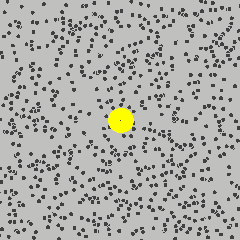If there was no gravity, in what direction would an object float?
No gravity means your liquid would form a sphere, unless you put it in a box.
It would float in whatever direction the forces created by differential heating, or any other turbulence inducing force, sends it in.
Ultimately, if you read about Einstein's work on Brownian Motion, in absolutely calm fluid, it's direction would be decided by the random motions of the molecules of the denser liquid.

This is a simulation of the Brownian motion of a big particle (dust particle) that collides with a large set of smaller particles (molecules of a gas) which move with different velocities in different random directions.
Here's another possibility:
Assuming there is a lot of water held in place by an atmosphere, some sort of thin crust, or anything else that can keep water liquid while preventing evaporation into the vacuum of space, the water would form a spherical planetoid under its own gravity.
Say the radius of the water planetoid is $R$ and the water density does not vary much under its own weight. Then a small but macroscopic body of volume $V$ and mass density $\rho = m/V \le \rho_{\text{water}}$ (that is, too massive to be affected by Brownian motion) will always float to the sphere's surface.
The general rule is that it will move in the direction of its apparent weight in the water: it should float to the surface if its local weight is lower then that of the water it displaces, it should fall to the center otherwise. But whatever the gravitational field $\bf g$ is at some location within the water sphere, for a small body the floating condition reads $$ m {\bf g} \le \rho_{\text{water}} V {\bf g} \;\;\; \Rightarrow \;\;\; m \le \rho_{\text{water}} V $$ or $$ \rho \le \rho_{\text{water}} $$ Note that the conclusion holds even if the density of water does increase under its own weight. All we need to do is account for $\rho_{\text{water}}(r )$.
If you'd like to consider explicitly the gravitational field of a water sphere of uniform density $\rho_{\text{water}}$, assuming Newtonian gravitation, apply Gauss' Law for a concentric sphere or radius $r \le R$ within its volume: $$ (4\pi r^2)\; |{\bf g}| = -4\pi G \left(\frac{4\pi r^3}{3}\right) \rho_{\text{water}} $$ so $$ {\bf g} = - \frac{4\pi G}{3} \rho_{\text{water}} {\bf r} $$